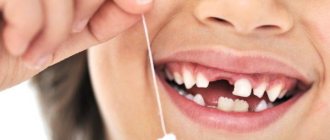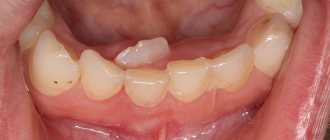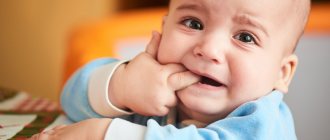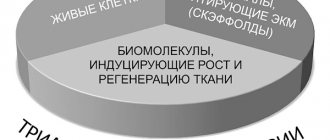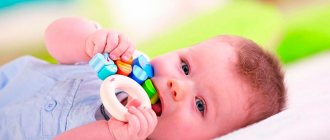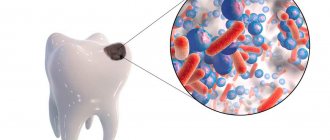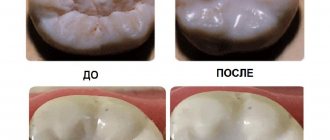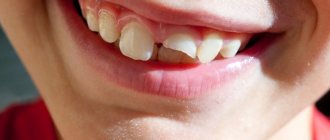How teeth are formed
The appearance of the first tooth is a milestone in a child's development. Now he's almost an adult! After all, his teeth will help him chew solid food and develop speech.
Baby teeth begin to form in the fetus as early as the 6th week of pregnancy. Between the 3rd and 6th months, enamel has already formed on the teeth. All this will be hidden under the gums for the time being. At the same time, deep in the jaw bone there are already the rudiments of molar teeth.
For most children, their first tooth appears between 4 and 7 months, but for some it happens later. With early development, it can erupt at 3 months or earlier. If the child grows normally and has no problems with skin and hair, then it’s okay. But if your baby is already 1.5 years old, and teeth have not appeared, you may need the help of a dentist.
The lower teeth usually appear about a month earlier than the upper teeth.
Approximate order of appearance of baby teeth:
- Lower central incisors (at 6 – 7 months).
- Upper central incisors (at 8 – 9 months).
- Upper lateral incisors (at 9–11 months).
- Lower lateral incisors (at 11 – 13 months).
- Upper small molars (molars) (at 12 – 15 months).
- Lower small molars (molars) (at 12 – 15 months).
- Upper canines (at 16 – 18 months).
- Lower canines (at 18 – 20 months).
- Lower large molars (molars) (at 24 – 30 months).
- Upper large (root) (at 23 – 30 months).
By age 3, your baby should have all 20 teeth, which will last until he is about 6 years old, when his first baby tooth falls out.
Don't be discouraged if your teeth grow crooked at first. Over time they will all fall into place.
Diagram of teething of primary occlusion
A newborn child has 20 primary tooth buds inside the upper and lower jaws (10 follicles for each jaw). The timing of teething in children, according to different authors, can vary greatly, and in diagram No. 1 below you can see generally accepted figures from the “National Guide to Pediatric Dentistry”. In this diagram you can see the timing of the eruption of baby teeth in completely healthy children who do not have any pathology.
Scheme of teething in children without pathology (scheme No. 1) –
According to statistics, the normal schedule for teething in children is observed only in 42% of cases. A delay in the timing of eruption is observed in approximately 48% of children, which is associated with illnesses suffered - both by the mother during pregnancy and by the newborn child (you can read about the main reasons for the delay in eruption below). Approximately 10% of all children experience early eruption of primary teeth, and in a small percentage of cases this can occur even during fetal development.
What may cause delayed teething?
Many factors can influence the delay in the eruption of primary teeth. For example, in premature children with general somatic pathology, the eruption of the first teeth in 61% of cases occurs only at the age of 8 months and older. Moreover, if a premature baby has suffered an intracranial birth injury or a severe infectious-inflammatory disease, then eruption may begin even later - at 11-12 months and older.
The timing of the onset of teething also depends on the duration of natural feeding. In bottle-fed children, in 60% of cases, the first temporary teeth erupt only at 8 months or later. In mixed-fed children, delayed eruption was observed in only 30% of cases. A lot depends on the state of health of the mother during pregnancy, as well as on the course of pregnancy. For example, when examining children under 3 years of age whose mothers suffered severe toxicosis, it was found that the start of the eruption of primary teeth in them shifted to 8-10 months.
It is also worth noting that delayed eruption in a small percentage of cases can occur even in completely healthy children, which is associated with a genetic factor (for example, when late eruption was observed in one of the child’s parents). The “National Guide to Pediatric Dentistry” published a table that clearly shows what the delay in eruption may be if a child has various diseases.
Table No. 1 - timing of the onset of eruption in the presence of pathology
List of reasons for delayed eruption of baby teeth:
1) The first group of reasons includes diseases of a woman during pregnancy, as well as features of the course of pregnancy. Moreover, it is worth noting that all these reasons have only a moderate effect (unlike diseases in the 1st year of a child’s life). These reasons include:
- toxicosis of the 2nd half of pregnancy,
- kidney disease,
- previous pneumonia or acute respiratory infection with high fever,
- herpes infection, rubella, toxoplasmosis,
- constant chronic or short-term severe stress.
2) The greatest influence on the delay in the eruption of primary teeth is caused by diseases suffered during the 1st year of the child’s life:
- neonatal sepsis,
- pneumonia, frequent acute respiratory infections,
- atopic dermatitis, rickets,
- general somatic pathology,
- convulsive states,
- intestinal toxicosis,
- prematurity and postmaturity,
- hypothyroidism (lack of iodine intake),
- poor unbalanced diet,
- for epilepsy.
Causes of early teething: studies have found that early teething is most often characteristic of children born with a large body weight. Moreover, there is a clear correlation - the greater the child’s body weight, the earlier the eruption of temporary teeth begins. Also, premature eruption is observed with adrenal tumors accompanied by hyperfunction (24stoma.ru).
Violation of the sequence of teething in children -
Physiological teething is characterized not only by timing, but also by such characteristics as pairing and sequence. Those. all teeth should erupt in pairs, for example, first 2 central incisors of the lower jaw erupt at once, then 2 central incisors of the upper jaw, etc. See diagram No. 1 above for the timing and sequence of baby teeth eruption. In healthy children, there are usually no violations of pairing and sequence during teething.
But in children who have suffered from rickets, sequence violations occur in approximately 52% of all cases, pairing disorders occur in approximately 35% of cases. In children with rickets, the eruption of primary teeth very often begins with the central and lateral incisors of the upper jaw, and when the crowns of the teeth erupt approximately halfway, the eruption process may stop for many months. The latter is associated with a violation of the formation of the roots of milk teeth, because when milk teeth just begin to erupt, their roots are still only 25-50% formed.
How to understand that your baby is teething (symptoms)
Many people believe that the process of teething must necessarily be accompanied by general anxiety of the baby, fever and diarrhea. However, not all experts share this point of view. Some consider this a mere coincidence. There is an opinion that children, when they start teething, are more likely to put dirty objects in their mouths to scratch their gums, and cause an infection.
Some lucky people go through this period painlessly.
But most children still experience some discomfort:
- Anxiety;
- Increased salivation, which can lead to facial irritation;
- The gums swell and become more sensitive;
- Refusal to eat;
- Bad dream.
If your baby has a fever or diarrhea, consult a doctor.
When will all the baby teeth come out?
All 20 baby teeth of a child must erupt before the age of 2.5 years. If this does not happen, you need to consult a specialist and rule out possible diseases of the endocrine system. The replacement of milk teeth will begin at the age of 6-7 years: from this moment, milk teeth will begin to fall out, and permanent (molar) teeth will grow in their place, the number of which in children and adolescents over 12 years old is 28. After 17-18 years, a person may two more closing molars will appear, which are called wisdom teeth.
At 2.5 years the child should have all baby teeth
The order of eruption of baby teeth in infants is in most cases the same. Exceptions are quite rare; they are explained by the individual physiological characteristics of the body and the anatomy of the structure of the maxillofacial apparatus. Knowing in what order teeth should appear in children in the first year of life, parents can monitor the correct development of the child and promptly consult a doctor if there are deviations from generally accepted dental norms and standards. Tempalgin for toothache read the article.
How to help your baby when teething
- Give your baby something to chew on, such as a teether, which can be pre-chilled in the refrigerator.
- Massage your baby's gums with a clean finger. You can first wrap your finger in clean gauze. This will relieve the pain for a while.
- If your baby is already eating solids, give him cool foods (applesauce or yogurt).
- You can give your child something hard to chew on, such as a cracker. Just make sure your baby doesn't choke.
- If all of the above does not help, you can give your child a baby pain reliever or a special teething gel - strictly after consulting a doctor.
Vomiting, runny nose and diarrhea are not always symptoms of teething. If your baby appears unwell, call the doctor.
Symptoms of teething in children
Signs of teething in infants can be observed already 3-5 days before teething. Symptoms continue until the crowns of the teeth appear through the mucous membrane of the gums. The main symptoms of teething in infants are:
- redness and swelling of the gums at the site of eruption,
- irritability,
- bad dream,
- poor appetite, refusal to eat,
- the child tries to bite whatever he can, trying to relieve the itching in the gums,
- increased salivation and drooling,
- rash and irritation in the mouth and chin area, as well as on the chest (occur due to drooling from the mouth).
→ Homeopathic remedies for teething → Pain-relieving gels for topical use
Additional signs of teething in children:
- How long does the temperature last during teething in children? For most children, teething does not lead to an increase in temperature.
High temperature is usually a consequence of some concomitant inflammatory process unrelated to teething. For example, it may increase against the background of ARVI, or against the background of herpetic stomatitis of the oral cavity (the latter is characterized by the symptoms described below). It is worth carefully examining the mucous membrane of the child’s oral cavity for the presence of - 1) small blisters filled with clear or cloudy liquid, 2) small erosions surrounded by inflamed bright red mucous membrane, 3) bright red inflamed gums. In a 1-year-old child, antibodies to the herpes virus received from the mother during pregnancy gradually disappear, and trauma to the mucous membrane from teething is a trigger for the development of viral stomatitis. - Hematomas on the mucous membrane of the gums (Fig. 8) - in some children, 2-3 weeks before teething, a lump filled with clear or bluish liquid may appear on the gum. This does not indicate inflammation or any pathology, and usually does not require intervention (only if this formation has reached too large a size, a small incision is made to release the bloody fluid).
- Coughing and vomiting during teething – increased salivation is observed during teething, and if the child has swallowed saliva, then such symptoms may be present. If vomiting occurs against the background of a high temperature or abnormal stool (diarrhea), then teething has nothing to do with it. In this case, you should immediately suspect rotavirus and urgently call a pediatrician home.
Important : we repeat once again that high fever, vomiting and diarrhea cannot in any way be associated with teething. Their causes are intoxication of the body against the background of a concomitant infectious process (influenza, ARVI), rotavirus infection. In these cases, you should definitely call a pediatrician.
If you find herpetic rashes (vesicles, erosions) on the mucous membrane of the child’s mouth, or all the gums are bright red, then this is typical for herpetic gingivostomatitis. In this case, it is better to call a pediatric dentist from a pediatric dental clinic at your place of residence, because Pediatricians in most cases do not know that there are several forms of stomatitis, each of which is treated differently.
Choosing a toothpaste and brush
Has your baby cut his first tooth? Congratulations!
- Until one year of age, parents need to brush their baby’s teeth without toothpaste using a special silicone brush placed on their finger at least once a day.
- At one year old, the baby needs to pick up his first children's toothbrush - without toothpaste for now. It is better if the child chooses it himself. She should interest him, but not scare him away.
What should you pay attention to when choosing a children's toothbrush?
- Decor - kids love bright colors and funny characters.
- The handle should be comfortable, preferably made of non-slip material with a protective ring to avoid injury. Its length should correspond to the age of the child.
- It is important that the brush head is not too large and awkward. The optimal size is 2–3 teeth of a child. To avoid damaging your gums, it is better to choose a brush with a rounded head.
- Soft brushes with a bristle height of no more than 11 mm are suitable for children. It should be even so that the pressure on the surface of the teeth is uniform.
- From 2 to 2.5 years old, it’s time to start using toothpaste and teach your child to brush his teeth on his own. You need to choose a special baby toothpaste without fluoride, because the baby may want to eat it. You can switch to fluoride toothpaste when he learns not to swallow it.
Period of eruption of permanent teeth -
The eruption of permanent teeth has a number of features, because... This process occurs simultaneously with the resorption of roots and loss of baby teeth. The rudiments of permanent teeth are located only 1-2 mm from the roots of milk teeth, and when a permanent tooth begins to erupt, it puts pressure on the roots of the milk tooth located above it, which leads to their resorption. Accordingly, baby teeth gradually lose contact with bone tissue, and their crowns become mobile.
And only the eruption of molars (large lateral chewing teeth) occurs without the loss of milk teeth, which is associated with a smaller number of the latter. By the way, in girls, the loss of baby teeth, as well as the beginning of the eruption of permanent teeth, occurs 4-7 months earlier than in boys, which is associated with hormonal levels. You can see the sequence and timing of the eruption of permanent teeth in children in diagram No. 2, which clearly shows the time ranges for the start of eruption for each permanent tooth.
Permanent teeth in children: order of eruption
The first permanent teeth to erupt are the first molars, which usually occurs at 6 years of age. True, recently, teething increasingly begins at the age of 5, and this is associated with the acceleration of the physical development of children. The process of eruption of permanent teeth ends by the age of 14 (with the exception of wisdom teeth). Teeth are considered fully erupted only when their chewing surface begins to contact the antagonist teeth of the opposite jaw, and the gums cover the crowns of the teeth only in the area of their neck.
Moreover, please note that the sequence of eruption of permanent teeth on the lower jaw differs from the sequence of eruption of teeth of the same name on the upper jaw. For example, in the lower jaw, the first molars and central incisors erupt simultaneously, while in the upper jaw, the first molars appear earlier. Moreover, absolutely all teeth (with the exception of premolars) erupt earlier in the lower jaw.
Beginning of replacement of baby teeth with permanent teeth (6 years) –
How to brush your teeth correctly
- Your baby's teeth need to be brushed 2 times a day - in the morning and in the evening before bed.
- Use a small amount of toothpaste at first, about the size of a grain of rice, then work up to a pea-sized amount.
- If you use such a small amount of toothpaste, there is no need to rinse your mouth.
- Brush your teeth gently from the outside and inside.
- The tongue also needs to be cleaned, because bacteria accumulate on it, causing bad breath.
- Remember to change your toothbrush every 3 months.
At this stage, it is too early to floss because the teeth are usually far apart.
Creating a good habit
The habit of brushing your teeth should be established in childhood. If you don’t force your child, but figure out how to turn this activity into an interesting game, your baby will brush his teeth with pleasure. Here are some tips:
- Children love to copy adults, so lead by example by brushing your teeth with your child.
- If you brush your teeth with your baby, at the end open your mouth and show each other how you handled this “task.” If necessary, clean your child's teeth yourself.
- Don't scold him, no matter how badly he cleaned it. Children at this age have not yet developed fine motor skills, so do not expect precise movements from them.
- Let your child associate brushing his teeth with something joyful. Play his favorite children's music, tell him stories about teeth, and draw on a dental theme.
- Keep a piece of paper with a schedule for brushing your teeth. Divide the day into morning and evening (you can draw the sun and moon there) and check the box when you brush your teeth.
- Finally, talk to your child like an adult. Explain to him why brushing his teeth is good. Draw scary microbes on a piece of paper and together figure out how you can fight them.
If your little one refuses to brush his teeth, try buying him a new toothbrush with his favorite cartoon character on it. Get him interested. Get several toothbrushes and let him choose a new one each time.
The first "bells"
The first signs of rapid teething are quite vague, but after observing the child for several days, you can notice changes in his well-being and behavior. Most babies begin to act restless, wake up more often at night, and eat less milk or formula about 4 weeks before the central incisors (these teeth appear first in children) erupt.
Baby teething
During this period, behavioral changes can be noted, listed in the table below.
Table. Changes in behavior during teething.
| Action | Why does the child behave this way? |
| Constantly puts toys, edges of clothing, and other objects he can reach into his mouth | This is explained by severe itching in the place where the tooth should appear: the top of the tooth rests on the gum, trying to break through the mucous tissue, and injures it, causing severe irritation. |
| More often requires the breast or asks to be held | Such behavioral changes are especially pronounced in breastfed children due to stronger emotional contact with their mother. For an infant, the breast is not only a source of food, but also a means of comfort, therefore, when experiencing pain and discomfort, the child instinctively looks for an object that he associates with positive emotions. For bottle-fed babies or mixed-fed babies, this item can be a bottle of milk or a pacifier. |
| Refuses to eat complementary foods, even if he previously ate them with pleasure | The explanation for the temporary refusal of foods introduced into the children's diet is due to physical discomfort and unpleasant sensations when the gums touch a spoon or other cutlery. If you give your child a raw apple or carrot during this period, most likely he will try to chew them with pleasure, since such movements provide gum massage and help soothe pain. This method must be used strictly under adult supervision due to the risk of accidental inhalation of small pieces! |
Changes during this period also affect children's sleep. Most babies fall asleep well, but begin to wake up frequently at night to breastfeed. It is impossible to fight this phenomenon - sleep returns to normal after the eruption of the frontal incisors and canines, which are the most painful. To relieve pain, you can use special gels with analgesic properties, for example, “Kamistad Baby” or “Kalgel”. They will also help reduce inflammation caused by trauma to the gums from the sharp tip of an erupting tooth.
"Kamistad Baby"
Important! If during a night's sleep a child wakes up too often, cannot fall asleep for a long time, and each rise is accompanied by a bout of severe crying, it is necessary to consult a doctor to rule out pathologies of the digestive system and other internal organs.
Severe crying during teething
What microelements are needed for teeth growth?
Fluorine
Fluoride strengthens tooth enamel, making it more resistant to acids and harmful bacteria. Thus, it helps prevent the development of caries.
Fluorine is found in:
- Toothpaste - however, remember that toothpaste with a small fluoride content can only be used by children over 4 years old;
- Fluoride-enriched water;
- Chewable tablets or drops;
- Some fruit juices.
Remember that too much fluoride can lead to fluorosis, which is when white spots appear on the teeth. Therefore, it is important not to use too much toothpaste, especially if the child has not yet learned to spit it out.
Calcium
Calcium takes an active part in the mineralization of teeth. A 3-year-old child should receive 800–1100 mg of calcium per day.
Products containing calcium:
- Milk, yogurt;
- Spinach and other green leafy vegetables;
- Broccoli;
- Fish.
In order for calcium to be better absorbed, it needs helpers. One is vitamin D and the other is vitamin K2.
Vitamin K
Calcium is collected and transported into bone tissue using the protein osteocalcin, which normally “dormants” peacefully in the blood. In order to activate it, you need natural vitamin K. It is found in dairy products (milk, yogurt, kefir, cottage cheese - for example, Agusha K2 cottage cheese).
When should I take my child to the dentist?
The Ministry of Health of the Russian Federation recommends showing a child to the dentist once a year starting from 12 months.
The purpose of the first trip to the dentist is prevention. The doctor checks whether teeth are growing correctly and gives recommendations on oral hygiene. It is better to do this no later than your first birthday, so that the specialist does not miss caries and possible problems with your bite.
The first trip to the dentist should not frighten your child.
Here are some tips to make it painless:
- Do not pay too much attention to this event, do not prepare your child on purpose;
- Don’t worry yourself so that your baby doesn’t get nervous along with you;
- If possible, arrive early to your appointment to give your baby time to look around.
